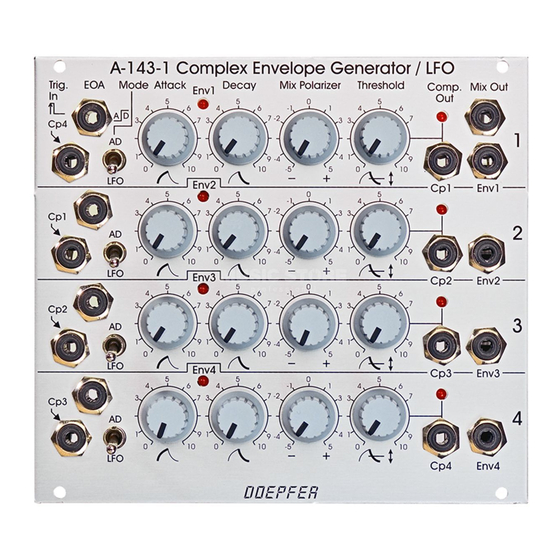
Advertisement
Quick Links
System A-100
Quad AD/LFO A-143-1
DOEPFER
1. Introduction
Module A-143-1 contains four independent Attack/Decay
generators. When the module is used as a complex
envelope generator, then two, three or four units are daisy-
chained, i.e. the preceding unit triggers the following unit.
But the four units can be used even as four separate AD
generators (mode switch in position AD) or free-running AD-
type LFOs (mode switch in position LFO). The LFO mode
differs in several points from a regular LFO (e.g. A-145, A-
146 or A-147), as the slopes are exponential - in contrast to
linear slopes of a normal LFO. In addition the frequency is
defined by both controls, as the attack control defines the
duration of the rising slope, while the decay control defines
the duration of the falling slope.
Each unit has available a comparator that compares the AD
output voltage against a manually adjustable threshold and
turns on the corresponding comparator output as soon as
the AD output voltage goes below the threshold level during
the decay phase. The comparator outputs are normalled to
the trigger inputs of the following stage via the switching
contacts of the trigger input sockets. Consequently the first
unit triggers the second, the second triggers the third and so
on (and the last unit triggers the first one).
Each AD/LFO unit also offers a polarizer control. This allows
adding or subtracting all AD/LFO signals to the mix output
with adjustable level. Additionally each unit features a single
envelope output and a digital "End Of Attack (EOA)" output,
that indicates the end of the attack phase.
Fig. 1: A-143-1 Controls, Inputs and Outputs
1
Advertisement

Summary of Contents for DOEPFER Quad AD/LFO A-143-1
- Page 1 System A-100 Quad AD/LFO A-143-1 DOEPFER 1. Introduction Module A-143-1 contains four independent Attack/Decay generators. When the module is used as a complex envelope generator, then two, three or four units are daisy- chained, i.e. the preceding unit triggers the following unit.
-
Page 2: Basic Principles
Quad AD/LFO A-143-1 System A-100 DOEPFER 2. Basic Principles The threshold setting defines the behaviour of the Comparator output (Cp Out). This output turns “low” as soon as the level of the envelope signal exceeds the threshold Fig. 2 shows the basic function of each unit: level. - Page 3 System A-100 Quad AD/LFO A-143-1 DOEPFER Provided that the trigger inputs are not patched the four units are daisy chained via the comparator outputs (Cp Out) as they are normalled via the switching contacts of the trigger input sockets, i.e. each unit is triggered by the Cp output of the preceding unit.
- Page 4 Quad AD/LFO A-143-1 System A-100 DOEPFER 3. Overview " § Fig. 5: A-143-1 front panel...
-
Page 5: Inputs And Outputs
System A-100 Quad AD/LFO A-143-1 DOEPFER Controls: Inputs and Outputs: AD/LFO : mode switch Trig. In : trigger input normalled to Cp 4 for unit 1 Attack: attack control (rising slope) normalled to Cp 1 for unit 2 normalled to Cp 2 for unit 3... -
Page 6: Controls, Inputs And Outputs
Quad AD/LFO A-143-1 System A-100 DOEPFER 3. Controls, Inputs and Outputs AD/LFO : mode switch This switch defines the function of the corresponding unit. In Trig. In : trigger input the upper position (AD) the envelope mode is selected, in the lower position (LFO) the free-running mode. - Page 7 System A-100 Quad AD/LFO A-143-1 DOEPFER Technical note: Threshold: threshold control for comparator § The envelope output (socket ) is set to “pre polarizer” in Cp x: comparator output (x = 1…4) the factory. Optional the output can be modified to “post comparator output display (LED) polarizer”...
- Page 8 Quad AD/LFO A-143-1 System A-100 DOEPFER 4. User Examples A special application of the quad AD generator is the The A-143-1 is suitable for all kinds of modulations where subsequent control of up to four similar modules (e.g. VCAs, normally LFOs or envelope generators are used. Please VCFs, VC phasers, VC flangers, VC frequency shifters …)


Need help?
Do you have a question about the Quad AD/LFO A-143-1 and is the answer not in the manual?
Questions and answers